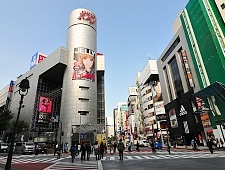
Fashion has been associated with privilege and exclusive designs. With mass production, we can generally suggest that clothing is more available than ever, but abundance has not eliminated social differences. The images above and below were created for the Salvation Army in 2007 and intended to shock. The ads read �You wouldn�t be seen dead in them but for a homeless person they could mean the difference between life and death. Please donate your unwanted clothes to the homeless this winter.�
Society has shifted from the era of modern production, the industrial revolution through the 60s, to postmodern excess, the 70s through the present. While social differences still exist, we now have over production of goods which combined with other factors, encourages an eventual democratization of fashion.
The democratization of fashion:
-the increase in amount and accessibility for fashion goods globally
-the decrease in exclusive specialty clothing (haute couture) with an increase of ready-to-wear
-the decrease of fashion authorities and increase of media and many voices
-a greater mixing of class, gender and cultural codes, with a decrease in barriers like formal & casual.

Pistoletto, Venus of Clothes, 1967
The democratization is part of what Fran�ois Lyotard called The Postmodern Condition in 1979. He saw a social decline of metanarratives or absolute right and wrong authorities. The consequence is abundant opinions but a postmodern crisis of meaning in which all meaning becomes unstable and people no longer know what is best.
Postmodernity accepts multiple opinions and emphasizes identity politics. This reduces the power of one group or hegemony. However in fashion the diversity of points of view results in an ambiguity of signs in which something like the tux or suit is no longer tied to one gender, class, form or environment, meaning that it has become highly subjective what to wear in different circumstances.
The more democratic postmodern moment causes people look to media for the answers and direction of what is right or wrong. Above left Vogue states it can tell you the answer of "what to wear?" Media authorizes and legitimizes fashion forms and specific designers. Below people make sense of brands through their associations with media personalities.
Above reality television fashion, is it a true democratic forum for talent? What about the open forum of blogging? Below there is an overall increase of teen power with social media and their engagement in contemporary style expression.
Fashion and media come together in intertextuality. Simply, a fashion sign makes sense only if you also know the other sign through a fluency of media.
Looking to the street has increased with more democratization. Above left celebrity street photographer Ron Galella and right Bill Cunningham. Below street style magazine i-D by Terry Jones.


Above Japanese street style for Fruits and below contemporary celebrity street style with Blake Lively. There is a larger question of the "myth of street style," if what gets documented is the exception, fashionistas, celebrities etc, and not the real street.


Author Sophie Woodward found that most people think they are the exception and defend their unique style but on close examination most people are simply mixing mass brands with occasional vintage or unique items. Below street style has influenced professional fashion photography, left for Harper's Bazaar April 2011 and right for Reserved.
Above the Cole Haan Spring 2010 campaign featured real women shot on the street in their shoes. Below the man behind the curtain in The Wizard of Oz and Yves Saint Laurent in 1995. There is a larger question if part of the democratization of fashion is simply its unveiling. The forces that held the power over fashion are slowly being exposed as the general public increases its power to influence fashion with a greater voice and visibility.

























































